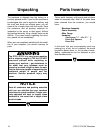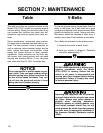
G7211/7212 24" Bandsaw -15-
Pre-Run Check
Bandsaw Blades
SECTION 6: OPERATIONS
The bandsaw is one of the most versatile
machines in the shop. It can cut miters, com-
pound angles, simple and complex curves, cir-
cles, and a wide variety of irregular shapes. It can
also rip and crosscut, as well as cut a variety of
joints. The bandsaw will also resaw stock into
thinner boards.
There are many adjustment points and compen-
sating differences to consider when operating this
type of saw. Therefore, cutting results can be
somewhat unpredictable if some or all of the cru-
cial adjustments are neglected. Here are a few
simple things you can do to increase the pre-
dictability of your bandsaw’s performance:
1. Always use a sharp, high-quality blade.
Although you might save a few dollars ini-
tially, buying a cheap blade will give you
cheap results. As a rule, spending more
now saves you money later.
2. Use the right blade for the job. Resawing
with a
1
/16" blade or doing scrollwork with a
1" blade are extreme examples of using the
wrong blade for the job.
3. Set the top guide assembly so it is just
above the top of the work at all times.
4. Allow the saw to cut. Don’t force the
workpiece into the blade. When cutting
curves or irregular shapes, remember that
while negotiating a curve, the blade should
still be cutting wood. Simply turning the
workpiece will only bind the blade and could
break it.
5. Maintain your bandsaw in top condition.
See the following section of this manual for
maintenance procedures.
A bandsaw blade is a delicate piece of steel sub-
jected to tremendous strain. Be sure you use
quality blades of the proper width for the various
types of cutting operations. The Grizzly
G7211/7212 24" Bandsaw accepts 154
1
⁄2" blades
ranging in widths from
1
⁄2" to 1
1
⁄4".
Always use the widest blade possible for the
workpiece you are cutting. Use narrow blades
only for sawing small, abrupt curves and for fine,
delicate work. Bandsaw blades can be purchased
welded, set, and sharpened ready-for-use from
Grizzly’s catalog or website.
Always select and use good-quality saw blades
and choose the right blade for the job. Poor qual-
ity blades and improper use are often the cause of
premature blade failure.
Many conditions can lead to breakage. Blade
breakage is, in some cases, unavoidable, since it
is the natural result of the peculiar stresses that
bandsaw blades are subjected to. Blade break-
age is also due to avoidable causes. Avoidable
breakage is most often the result of poor care or
judgement on the part of the operator when
mounting or adjusting the blade or support
guides. The most common causes of blade break-
age are: (1) faulty alignment and adjustment of
the guides; (2) forcing or twisting a wide blade
around a curve or short radius; (3) feeding too
fast; (4) tooth dullness or absence of sufficient
set; (5) excessive tension; (6) upper blade guide
assembly set too high above the workpiece; (7)
using a blade with a lumpy or improperly finished
weld; and (8), continuously running the bandsaw
when not in use.


















